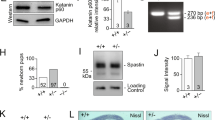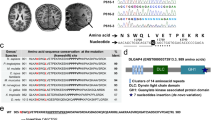Abstract
Mutations in the EFHC1 gene are linked to juvenile myoclonic epilepsy (JME), one of the most frequent forms of idiopathic generalized epilepsies. JME is associated with subtle alterations of cortical and subcortical architecture, but the underlying pathological mechanism remains unknown. We found that EFHC1 is a microtubule-associated protein involved in the regulation of cell division. In vitro, EFHC1 loss of function disrupted mitotic spindle organization, impaired M phase progression, induced microtubule bundling and increased apoptosis. EFHC1 impairment in the rat developing neocortex by ex vivo and in utero electroporation caused a marked disruption of radial migration. We found that this effect was a result of cortical progenitors failing to exit the cell cycle and defects in the radial glia scaffold organization and in the locomotion of postmitotic neurons. Therefore, we propose that EFHC1 is a regulator of cell division and neuronal migration during cortical development and that disruption of its functions leads to JME.
This is a preview of subscription content, access via your institution
Access options
Subscribe to this journal
Receive 12 print issues and online access
$209.00 per year
only $17.42 per issue
Buy this article
- Purchase on Springer Link
- Instant access to full article PDF
Prices may be subject to local taxes which are calculated during checkout







Similar content being viewed by others
References
Delgado-Escueta, A.V. et al. Mapping and positional cloning of common idiopathic generalized epilepsies: juvenile myoclonus epilepsy and childhood absence epilepsy. Adv. Neurol. 79, 351–374 (1999).
Delgado-Escueta, A.V. & Enrile-Bacsal, F. Juvenile myoclonic epilepsy of Janz. Neurology 34, 285–294 (1984).
Meencke, H.J. & Janz, D. Neuropathological findings in primary generalized epilepsy: a study of eight cases. Epilepsia 25, 8–21 (1984).
Woermann, F.G., Free, S.L., Koepp, M.J., Sisodiya, S.M. & Duncan, J.S. Abnormal cerebral structure in juvenile myoclonic epilepsy demonstrated with voxel-based analysis of MRI. Brain 122, 2101–2108 (1999).
Delgado-Escueta, A.V. Advances in genetics of juvenile myoclonic epilepsies. Epilepsy Curr. 7, 61–67 (2007).
Cossette, P. et al. Mutation of GABRA1 in an autosomal dominant form of juvenile myoclonic epilepsy. Nat. Genet. 31, 184–189 (2002).
Haug, K. et al. Mutations in CLCN2 encoding a voltage-gated chloride channel are associated with idiopathic generalized epilepsies. Nat. Genet. 33, 527–532 (2003).
Suzuki, T. et al. Mutations in EFHC1 cause juvenile myoclonic epilepsy. Nat. Genet. 36, 842–849 (2004).
Annesi, F. et al. Mutational analysis of EFHC1 gene in Italian families with juvenile myoclonic epilepsy. Epilepsia 48, 1686–1690 (2007).
Ma, S. et al. Mutations in the GABRA1 and EFHC1 genes are rare in familial juvenile myoclonic epilepsy. Epilepsy Res. 71, 129–134 (2006).
Stogmann, E. et al. Idiopathic generalized epilepsy phenotypes associated with different EFHC1 mutations. Neurology 67, 2029–2031 (2006).
Medina, M.T. et al. Novel mutations in Myoclonin1/EFHC1 in sporadic and familial juvenile myoclonic epilepsy. Neurology 70, 2137–2144 (2008).
Ikeda, T. et al. The mouse ortholog of EFHC1 implicated in juvenile myoclonic epilepsy is an axonemal protein widely conserved among organisms with motile cilia and flagella. FEBS Lett. 579, 819–822 (2005).
Suzuki, T. et al. Sequential expression of Efhc1/myoclonin1 in choroid plexus and ependymal cell cilia. Biochem. Biophys. Res. Commun. 367, 226–233 (2008).
King, S.M. Axonemal protofilament ribbons, DM10 domains and the link to juvenile myoclonic epilepsy. Cell Motil. Cytoskeleton 63, 245–253 (2006).
de Nijs, L. et al. EFHC1, a protein mutated in juvenile myoclonic epilepsy, associates with the mitotic spindle through its N-terminus. Exp. Cell Res. 312, 2872–2879 (2006).
Grisar, T. et al. Some genetic and biochemical aspects of myoclonus. Neurophysiol. Clin. 36, 271–279 (2006).
Gupta, A., Tsai, L.H. & Wynshaw-Boris, A. Life is a journey: a genetic look at neocortical development. Nat. Rev. Genet. 3, 342–355 (2002).
LoTurco, J.J. & Bai, J. The multipolar stage and disruptions in neuronal migration. Trends Neurosci. 29, 407–413 (2006).
Shu, T. et al. Doublecortin-like kinase controls neurogenesis by regulating mitotic spindles and M phase progression. Neuron 49, 25–39 (2006).
Nadarajah, B. & Parnavelas, J.G. Modes of neuronal migration in the developing cerebral cortex. Nat. Rev. Neurosci. 3, 423–432 (2002).
Hand, R. et al. Phosphorylation of Neurogenin2 specifies the migration properties and the dendritic morphology of pyramidal neurons in the neocortex. Neuron 48, 45–62 (2005).
Heng, J.I. et al. Neurogenin 2 controls cortical neuron migration through regulation of Rnd2. Nature 455, 114–118 (2008).
Saffin, J.M. et al. ASAP, a human microtubule-associated protein required for bipolar spindle assembly and cytokinesis. Proc. Natl. Acad. Sci. USA 102, 11302–11307 (2005).
Aonuma, M. et al. Microtubule bundle formation and cell death induced by the human CLASP/Orbit N-terminal fragment. Cell Struct. Funct. 30, 7–13 (2005).
Martínez-López, M.J. et al. Mouse neuron navigator 1, a novel microtubule-associated protein involved in neuronal migration. Mol. Cell. Neurosci. 28, 599–612 (2005).
Faulkner, N.E. et al. A role for the lissencephaly gene LIS1 in mitosis and cytoplasmic dynein function. Nat. Cell Biol. 2, 784–791 (2000).
Wakefield, J.G., Stephens, D.J. & Tavare, J.M. A role for glycogen synthase kinase-3 in mitotic spindle dynamics and chromosome alignment. J. Cell Sci. 116, 637–646 (2003).
Ohnuma, S. & Harris, W.A. Neurogenesis and the cell cycle. Neuron 40, 199–208 (2003).
Noctor, S.C., Martinez-Cerdeno, V., Ivic, L. & Kriegstein, A.R. Cortical neurons arise in symmetric and asymmetric division zones and migrate through specific phases. Nat. Neurosci. 7, 136–144 (2004).
Feng, Y. & Walsh, C.A. Mitotic spindle regulation by Nde1 controls cerebral cortical size. Neuron 44, 279–293 (2004).
Pontious, A., Kowalczyk, T., Englund, C. & Hevner, R.F. Role of intermediate progenitor cells in cerebral cortex development. Dev. Neurosci. 30, 24–32 (2008).
Kowalczyk, T. et al. Intermediate neuronal progenitors (basal progenitors) produce pyramidal-projection neurons for all layers of cerebral cortex. Cereb. Cortex published online, doi:10.1093/cercor/bhn260 (23 January 2009).
Roegiers, F. & Jan, Y.N. Asymmetric cell division. Curr. Opin. Cell Biol. 16, 195–205 (2004).
Yamashita, Y.M., Jones, D.L. & Fuller, M.T. Orientation of asymmetric stem cell division by the APC tumor suppressor and centrosome. Science 301, 1547–1550 (2003).
Noctor, S.C., Flint, A.C., Weissman, T.A., Dammerman, R.S. & Kriegstein, A.R. Neurons derived from radial glial cells establish radial units in neocortex. Nature 409, 714–720 (2001).
Rakic, P. Mode of cell migration to the superficial layers of fetal monkey neocortex. J. Comp. Neurol. 145, 61–83 (1972).
Halfter, W., Dong, S., Yip, Y.P., Willem, M. & Mayer, U. A critical function of the pial basement membrane in cortical histogenesis. J. Neurosci. 22, 6029–6040 (2002).
Hartfuss, E. et al. Reelin signaling directly affects radial glia morphology and biochemical maturation. Development 130, 4597–4609 (2003).
Tanaka, T. et al. Lis1 and doublecortin function with dynein to mediate coupling of the nucleus to the centrosome in neuronal migration. J. Cell Biol. 165, 709–721 (2004).
Tsai, L.H. & Gleeson, J.G. Nucleokinesis in neuronal migration. Neuron 46, 383–388 (2005).
Yingling, J. et al. Neuroepithelial stem cell proliferation requires LIS1 for precise spindle orientation and symmetric division. Cell 132, 474–486 (2008).
Tsai, J.W., Chen, Y., Kriegstein, A.R. & Vallee, R.B. LIS1 RNA interference blocks neural stem cell division, morphogenesis, and motility at multiple stages. J. Cell Biol. 170, 935–945 (2005).
Shu, T. et al. Ndel1 operates in a common pathway with LIS1 and cytoplasmic dynein to regulate cortical neuronal positioning. Neuron 44, 263–277 (2004).
Suzuki, T. et al. Efhc1 deficiency causes spontaneous myoclonus and increased seizure susceptibility. Hum. Mol. Genet. 18, 1099–1109 (2009).
Corbo, J.C. et al. Doublecortin is required in mice for lamination of the hippocampus but not the neocortex. J. Neurosci. 22, 7548–7557 (2002).
Bai, J. et al. RNAi reveals doublecortin is required for radial migration in rat neocortex. Nat. Neurosci. 6, 1277–1283 (2003).
Ramos, R.L., Bai, J. & LoTurco, J.J. Heterotopia formation in rat, but not mouse, neocortex after RNA interference knockdown of DCX. Cereb. Cortex 16, 1323–1331 (2006).
Young-Pearse, T.L. et al. A critical function for beta-amyloid precursor protein in neuronal migration revealed by in utero RNA interference. J. Neurosci. 27, 14459–14469 (2007).
Nguyen, L. et al. p27kip1 independently promotes neuronal differentiation and migration in the cerebral cortex. Genes Dev. 20, 1511–1524 (2006).
Acknowledgements
We thank B. Coumans for skillful technical assistance, J. Bai for help with in utero electroporation processing and S. Ormenese from the GIGA-Imaging and Flow Cytometry platform for support with flow cytometry. We are also grateful to A. Adamantidis for critical reading of the manuscript. We thank F. Polleux for the NeuroD-IRES-GFP plasmid. This work was supported by grants from the F.R.S.-FNRS (Fonds de la Recherche Scientifique Médicale 3.4565.03 to T.G. and B.L.) and the Léon Fredericq Foundation (to L.d.N.). L.N. and B.L. are research associates at the F.R.S.-FNRS.
Author information
Authors and Affiliations
Contributions
L.d.N. performed all of the experiments (except for immunoprecipitations), data analysis and wrote the manuscript with help from and editing by all the co-authors. C.L. conducted immunoprecipitations experiments. L.N. helped with the ex vivo and focal electroporation processing. J.J.L. trained L.d.N. for in utero electroporation studies and gave advice as to the interpretation of data. A.V.D.-E. provided plasmids and strong scientific support. T.G. and B.L. were the project leaders. They directed the follow-up of all experiments and supervised the data analysis.
Corresponding author
Supplementary information
Supplementary Text and Figures
Supplementary Figures 1 and 2 (PDF 1355 kb)
Rights and permissions
About this article
Cite this article
de Nijs, L., Léon, C., Nguyen, L. et al. EFHC1 interacts with microtubules to regulate cell division and cortical development. Nat Neurosci 12, 1266–1274 (2009). https://doi.org/10.1038/nn.2390
Received:
Accepted:
Published:
Issue Date:
DOI: https://doi.org/10.1038/nn.2390
This article is cited by
-
A systematic review of resting-state and task-based fmri in juvenile myoclonic epilepsy
Brain Imaging and Behavior (2022)
-
Epilepsy protein Efhc1/myoclonin1 is expressed in cells with motile cilia but not in neurons or mitotic apparatuses in brain
Scientific Reports (2020)
-
Bildgebung beim Janz-Syndrom (juvenile myoklonische Epilepsie)
Zeitschrift für Epileptologie (2020)
-
The transcriptomic responses of the ark shell, Anadara broughtonii, to sulfide and hypoxia exposure
Molecular Biology Reports (2019)
-
The Genetics of Common Epilepsy Disorders: Lessons Learned from the Channelopathy Era
Current Genetic Medicine Reports (2014)



